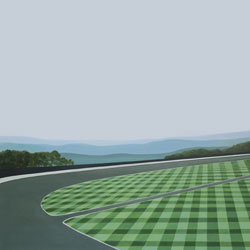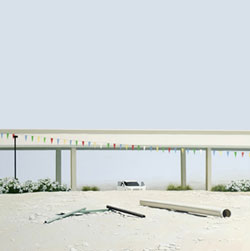
December 22, 2008
Longstreth, Jake: Dystopian Exurban Landscapes
By John Zarobell

Crematory, 2008
Acrylic on canvas
48 x 48 in.

Campus, 2008
Acrylic on canvas
48 x 48 in.

Dealer, 2008
Acrylic on canvas
36 x 36 in.
If, as Denis Cosgrove has written, landscape is a manner of seeing, the paintings of Jake Longstreth (currently on view until January 31st at Gregory Lind Gallery) introduce a new chapter in the history of landscape based not only on what he sees but on how he sees. On one hand, the places Longstreth chooses to depict such as parking lots and big box stores do not coincide with any romantic notions of nature. The photographs of Robert Adams, Henry Wessel and Ed Ruscha come to mind, as do the dystopic landscapes of Rackstraw Downs. But it is not only these obverse spaces that challenge our landscape ideas, it is the way the artist seems to channel something of the blankness of digital images seen on a flat screen, a kind of visual equalization that puts landscape pictures on a level with email. While this effect can be sensed it is hard to define.
"Campus" is a mixed-use landscape, in which the bucolic is partially tarred over ("They paved paradise and put up a parking lot"). The low distant hills yield to a hazy gray sky, mirrored by the darker gray of the pavement below, which is broken up by the geometric forms of the slanted parking lines and a few orange cones added for pictorial interest. The red hat in the green landscape was Corot's signature and with the choice of palette and the quality of light here, it seems that Longstreth has not entirely dispensed with the nineteenth century.
"Dealer" however is entirely of the twentieth. White California light illuminates this nearly abandoned space subdivided by a bridge perfectly cancelled by a colorful but humorless series of suspended flags. Such anesthetic places are mother's milk to any inhabitant of a western state and the distant rhododendrons do little to animate this deserted territory. The handling is a bit precious here, a bit over refined. The bridge is a white ruler on stilts, the pipes in the foreground carefully situated.
Longstreth's restrained technique seems almost to work against the tradition of landscape painting so long affiliated with personal and artistic soul-searching. "Crematory" is the best example of a landscape so groomed as to appear utterly artificial and it is here where the painter's technique and subject find an explicit harmony. This place is no liminal terrain but a carefully designed domain. Even the grass cutting is manipulated to create a pattern and the artist's mediation of this space doubles the effect. His multiple layers so carefully applied, his linear design which so coolly etches this view into our consciousness, is so subtle it seems to disappear. Unlike Robert Bechtle's eerie suburban absences, this place inspires a curious paradox of presence amidst emtiness. While Bechtle's muse is the analog snapshot, Longstreth channels the carefully pitched and edited digital image and thereby achieves a subversion of space. It is a triumph of mediation.
When seeing a landscape on the flat screen, it can appear more vivid than it actually is. Lawns glow and vapor dissipates, even as the actual character of the terrain dissolves. Space becomes pattern, recognizable but hyper-real so that we know that its artificiality is naturalized. This is how "Crematory" works. Through the elegant curves offset by linear repetition, the contrivance of space that has always been at the heart of landscape painting is joined with the contrivance of the digital image perceived on a screen. We do not long to walk in there, it is complete as an image. Longstreth's greatest strength as a painter is that he makes us come to see that the space we always longed for in landscapes is not out there in the world but our mind's eye. These days, our fantasies of the world are fed by our time spent online.
Jake Longstreth "All It Is: New Paintings," Gregory Lind Gallery, through January 31, 2009.
49 Geary Street, 5th Floor, San Francisco; Tues-Sat 10:30-5:30; (415) 296-9661; info@gregorylindgallery.com